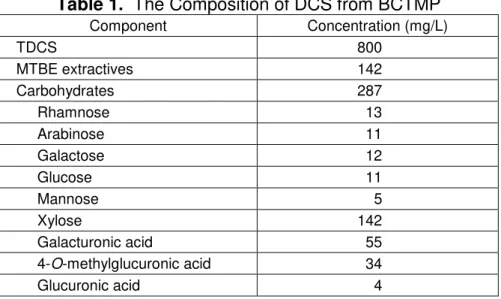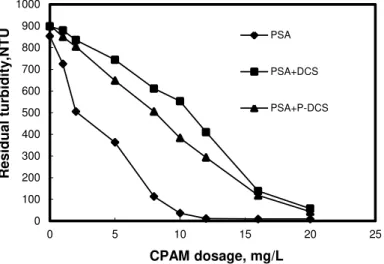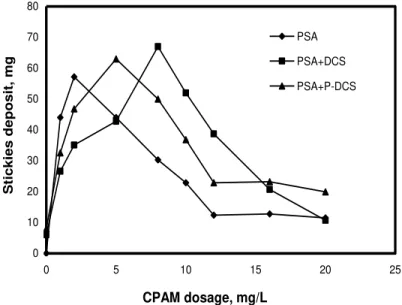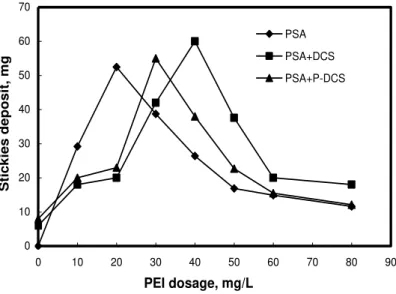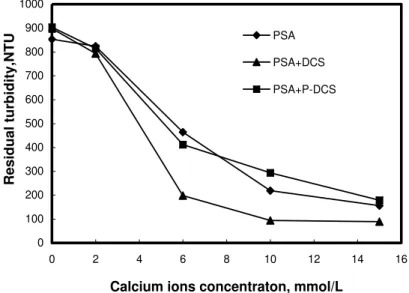PEER-REVIEWED ARTICLE
bioresources.
com
Stickies Control with Pectinase for Improving Behavior
of Cationic Polymers in a Mixture of
Chemithermo-mechanical Pulp and Deinked Pulp
Zongquan Li,a,b,* Congxiang Liu,a Menghua Qin,a Yingjuan Fu,a and Yang Gao a,b
In this work, a pressure-sensitive adhesive (PSA) was used as the model substance for secondary stickies. The dissolved and colloidal substances (DCS) prepared from bleached chemithermomechanical pulp (BCTMP) and the effects of pectinase treatment on the stickies deposition were evaluated. The results showed that the addition of DCS lowered the efficiency of cationic polymers and aggravated the deposition of stickies. As a major component of anionic DCS, polygalacturonic acids can be effectively degraded during pectinase treatment. Therefore, the efficiency of cationic polymers improved, and subsequently they were able to fix the destabilized sticky particles on the fibers, which led to the decrease of stickies deposition. However, the pectinase treatment of DCS insignificantly affected stickies deposition in absence of cationic polymers when the stickies deposition was caused by calcium ions.
Keywords:Pectinase; BCTMP; Dissolved and colloidal substances; Polygalacturonic acids
Contact information: a: Key Laboratory of Pulp & Paper Science and Technology (Shandong Polytechnic University), Ministry of Education, Ji’nan, Shandong, 250353 China; b: Huatai Group Co. Ltd., Guangrao,
Shandong, 257335 China; *Corresponding author:pplizongquan@163.com
INTRODUCTION
Stickies remains one of the major obstacles in paper mills, not only negatively affecting the operation of the paper machine, but also harming the quality of the final products. While using recovered papers as raw materials for papermaking, they can build up on the forming wire, the pressing felt, in the dryer section, and in the calender section (Douek et al. 2003; Hubbe et al. 2006). Compared to using one type of pulp, the problems caused by stickies are even more critical for a production line that utilizes a mixture of several pulps, such as mechanical pulp, deinked pulp, etc. (Allen 2002; Lenes et al. 2001; Dechandt et al. 2004). The sticky substances existing in different pulps increase the complexity of stickies problems when they are blended together (Dechandt et al. 2004; Haynes 2008).
PEER-REVIEWED ARTICLE
bioresources.
com
their size is reduced, and subsequently smaller compounds are formed (Jones 2005; Patrick 2004; Jones et al. 2010).
Cationic polymers, such as cationic polyacrylamide and polyethylene-imine, are widely used as retention aids in the wet end of a paper system. In addition to retaining the fillers and fines, they can also affix some sticky particles onto the pulp fibers, therefore reducing the deposition of stickies. However, the negatively charged dissolved and colloidal substances (DCS) that are released during the pulping and bleaching processes deteriorate the efficiency of cationic polymers. The polygalacturonic acids dissolved during the bleaching stage of mechanical pulping are considered a main source of anionic DCS (Reid and Ricard 2000; Liu et al. 2010), and these are responsible for the deposition of sticky substances in subsequent papermaking processes (Li et al. 2006a). Additionally, the polygalacturonic acids in mechanical pulp can be degraded by pectinase, which inhibits the problems caused by DCS and improves the behavior of cationic polymers (Ricard et al. 2004; Thornton 1994; Pruszynski et al. 2011).
Bleached chemithermomechanical pulp is used extensively in producing fine paper grades, due to its unique properties such as high bulk, high opacity, good ink absorption, and low production cost (Connell and Cockram 2000; Zhou 2004; Hu et al. 2004). DCS formed and released during the pulping processes of CTMP are negatively charged, and these detrimental substances, especially polygalacturonic acids, will affect the efficiency of cationic polymers in the wet end stage of a papermaking system (Li et al. 2006b; Zhang et al. 2011). As a bio-chemical approach for DCS treatment, pectinase has demonstrated the ability to degrade the polygalacturonic acids in DCS and subsequently improve the effectiveness of cationic polymers (Li et al. 2006b; Ricard et al. 2004). The treatment of whitewater from papermaking by using a combination of pectinase and lipase was an effective method for the reduction of cationic demand of whitewater and pitch deposition (Liu et al. 2012).
In this study, a polyacrylate pressure-sensitive adhesive (PSA) was used as a model substance of secondary stickies in DIP. The effectiveness of pectinase treatment on the DCS and its control of the deposition of sticky substances are evaluated and discussed.
EXPERIMENTAL
Materials and Chemicals
PEER-REVIEWED ARTICLE
bioresources.
com
Preparation of DCS from BCTMP
To investigate how the pectinase acts on DCS, a DCS sample was prepared from BCTMP in the laboratory. The pulp was firstly diluted with deionized water (60°C) to 2% consistency, stirred at 100 rpm for 1 hour, and then filtrated with a 200-mesh wire. The filtrate was left to stand for 24 h, and then filtrated with a G3 filtering crucible to acquire the DCS sample.
Analysis of DCS and PSA
The DCS sample was extracted with methyl tert-butyl ether (MTBE), according to the method by Örså and Holmbom (1994). The total dissolved and colloidal substances (TDCS) in the DCS sample were determined by the gravimetric method (Zhang 2000). The degraded carbohydrates present in DCS samples were determined by gas chromatography (GC) after methanolysis treatment, according to the method described by Sundberg et al. (1996). The cationic demand (CD) of DCS and the negative charge density of PSA was determined with a Mütek PCD 03 particle charge detector, and poly-(dimethyldiallylammonium chloride) was used as a standard cationic substance (Ben et al. 2003). The CD of the prepared DCS and the negative charge density of PSA at a pH of 7.5 were 210 μeq/L and 0.25 meq/g, respectively.
Application of Pectinase to DCS Sample
To examine the degradation of polygalacturonic acids in DCS samples, the pectinase treatment conditions were as follows: the dosage of the enzyme was 150 APSU/L, enzymatic treatment was carried out at 55°C, at a pH of 5.0, for 180 min. After the pectinase treatment, the cationic demand of the DCS sample was examined. For comparison, the DCS sample was also treated with deactivated pectinase and underwent enzymatic treatment under the same conditions.
Examination of Deposition of Sticky Substances
To evaluate the effectiveness of pectinase in controlling stickies, the deposition of sticky substances was examined using a method found in the literature (Li et al. 2005). The device consisted of a Plexiglas container with a removable polythene cylinder that was placed in the container by a holder. Holes with a diameter of 0.4 cm were distributed along the wall of the cylinder, and the effective area of the cylinder was about 500 cm2. During the deposition test, the pre-weighed cylinder was placed in the device, into which 800 mL of DCS sample and 1200 mL hot deionized water were added. The pulp sample and the PSA latex (or DCS sample or pectinase-treated DCS, if applicable) were then added, and the experiment was started at an agitation speed of 750 rpm. The rotator was also pre-weighed. According to the scheme, the cationic polymers or calcium ions were added into the suspension, and the pH value was adjusted if/when needed. After running for 60 min, the polythene cylinder and the rotator were removed from the device and rinsed with water, then dried at 105°C for 15 min to acquire the weight of the deposited substances. An average of duplicate measurements was recorded as the result, and their difference was less than 10%. Additionally, the suspension after the deposition test was centrifuged, and the turbidity of the supernatant was used for turbidity determination.
PEER-REVIEWED ARTICLE
bioresources.
com
g/L, pulp consistency of 0.4%, temperature of 50°C, pH of 7.5, and a deposition time of 60 min.
Fig. 1. Diagram of the stickies deposition tester
Microscopic Observation of Stickies on Fibers
In the deposition test, to observe the sticky substances attached to pulp fibers, after 1 minute of adding cationic polymers, the pulp fibers were observed and imaged with a BK2000/3000 light microscope (Chongqing Photoelectric Instrument Co. Ltd., China).
RESULTS AND DISCUSSION
Composition of DCS from BCTMP
The composition of DCS from BCTMP was instrumentally analyzed, and the results are shown in Table 1.
Table 1. The Composition of DCS from BCTMP
Component Concentration (mg/L)
TDCS 800
MTBE extractives 142
Carbohydrates 287
Rhamnose 13
Arabinose 11
Galactose 12
Glucose 11
Mannose 5
Xylose 142
Galacturonic acid 55
4-O-methylglucuronic acid 34
Glucuronic acid 4
Shaft
Container
Polythene cylinder
PEER-REVIEWED ARTICLE
bioresources.
com
It can be seen that the total DCS was about 800 mg/L, and the degraded components from carbohydrates remained the major components in the DCS sample. The xylose accounted for 142 mg/L, while other monosugars were only in the range of 11 to 13 mg/L. In addition to monosugars, galacturonic acid and 4-O-methylglucuronic acid were predominant components in the DCS sample. These degraded carbohydrates should be released during the pulping and bleaching processes of BCTMP and DIP.
Effect of Pectinase Treatment on DCS in the Presence of Cationic Polymers
The negatively charged DCS in pulps significantly affected the efficiency of cationic polymers when applied to the papermaking system for the retention of fillers and fine fibers. In order to examine the effectiveness of pectinase treatment on DCS in the mixture of BCTMP and DIP, the stability of secondary stickies and the stickies deposition was examined in the presence of CPAM and PEI. The results are shown in Figs. 2 to 5.
It was reported that the residual turbidity could be an indicator of the destabilization of the colloidal system when cationic polymers are added (Huo et al. 2001). Compared to the individual colloidal PSA system, Figs. 2 and 3 show that with addition of DCS, more cationic polymers were required for flocculating the PSA, which means that the effectiveness of cationic polymers was negatively affected in the presence of DCS.
0 100 200 300 400 500 600 700 800 900 1000
0 5 10 15 20 25
Resi
d
u
al
tu
rb
idit
y
,NT
U
CPAM dosage, mg/L PSA
PSA+DCS
PSA+P-DCS
Fig. 2. Effect of CPAM on the stability of colloidal system
PEER-REVIEWED ARTICLE
bioresources.
com
0 100 200 300 400 500 600 700 800 900 1000
0 10 20 30 40 50 60 70 80 90
PEI dosage, mg/L
Resi
d
u
al
tu
rb
idit
y,
NT
U PSA
PSA+DCS
PSA+P-DCS
Fig. 3. Effect of PEI on the stability of colloidal system
0 10 20 30 40 50 60 70 80
0 5 10 15 20 25
CPAM dosage, mg/L
S
tick
ies
dep
o
sit, mg
PSA
PSA+DCS
PSA+P-DCS
Fig. 4. Effect of CPAM on stickies deposition of colloidal system
PEER-REVIEWED ARTICLE
bioresources.
com
0 10 20 30 40 50 60 70
0 10 20 30 40 50 60 70 80 90
PEI dosage, mg/L
S
tick
ies
dep
o
sit, mg
PSA
PSA+DCS
PSA+P-DCS
Fig. 5. Effect of PEI on stickies deposition of colloidal system
The stickies deposited from the PSA + DCS system were less than that from the PSA system, even at a low dosage of cationic polymers. The negatively charged DCS was helpful in stabilizing the PSA colloidal particles in the presence of cationic polymers. However, the sticky particles were not easily removed from the system with a low level of cationic polymers. To control sticky problems, the level of cationic polymers should be higher than the point that led to the maximum deposition of stickies. To reduce the sticky deposits to a similar level, more cationic polymers were required for the PSA + DCS system than for the PSA system, because the negatively charged DCS deteriorates the effectiveness of cationic polymers.
Compared to the PSA + DCS system, for the pectinase-treated sample, the deposited stickies decreased at the same dosage of cationic polymers, and lower amounts of cationic polymers were required to decrease the sticky deposition to a similar level. For example, to reduce the sticky deposition to about 20 mg, the necessary amount of CPAM was 16 mg/L and 12 mg/L, respectively, for the PSA + DCS and PSA + P-DCS systems.
In summary, the anionic trash in dissolved and colloidal substances decreased after the pectinase treatment, so that the efficiency of cationic polymers improved, i.e., pectinase treatment benefited stickies control.
Effect of Pectinase Treatment on DCS in the Presence of Calcium Ions
Calcium ions are one of the metal ions that commonly exist in pulp suspension and process water in newsprint mills. They can cause the destabilization of secondary stickies and lead to deposition of stickies.
PEER-REVIEWED ARTICLE
bioresources.
com
0 100 200 300 400 500 600 700 800 900 1000
0 2 4 6 8 10 12 14 16
Calcium ions concentraton, mmol/L
Resi
d
u
al
tu
rb
idit
y,NTU
PSA
PSA+DCS
PSA+P-DCS
Fig. 6. Effect of calcium ions on the stability of colloidal systems
0 50 100 150 200 250
0 5 10 15 20
Calcium ions concention, mmol/L
S
tick
ies
dep
o
sit, mg
PSA
PSA+DCS
PSA+P-DCS
Fig. 7. Effect of calcium ions on the stickies deposition
Figure 6 shows that, compared to the PSA system and the PSA + P-DCS system, it was easier to destabilize the PSA + DCS system by adding calcium ions. This can be explained by the formation of a complex between polygalacturonic acids and calcium ions, which may absorb and flocculate the colloidal particles and destabilize the latter. Meanwhile, in the presence of calcium ions, the polygalacturonic acids were hydrolyzed by pectinase, and their effect on the stability of the colloidal system was eliminated.
PEER-REVIEWED ARTICLE
bioresources.
com
Microscopic Observation of Stickies Adsorbed on Fibers
It can be seen from Fig. 8(a) that, in presence of 40 mg/L PEI, many sticky floccules were adsorbed on the fibers in the PSA system and did not tend to be deposited.
(a) PEI 40 mg/L, PSA system
(b) PEI 40 mg/L, PSA+DCS system
(c) PEI 40 mg/L, PSA+P-DCS system
PEER-REVIEWED ARTICLE
bioresources.
com
At the same addition of PEI, fewer sticky floccules on the fibers, i.e., some free floccules, were observed after adding prepared DCS, as shown in Fig. 8(b). Due to the
DCS’s negative effect on the efficiency of cationic polymers, it may be suggested that the
destabilized sticky floccules could not be adsorbed on the fibers because of cationic polymers. The free destabilized sticky particles were more easily deposited because they were not adsorbed on the fibers. After treating the DCS with pectinase, fewer free sticky floccules were observed, while more sticky floccules were absorbed on the fibers, as shown in Fig. 8(c), which led to a decrease of stickies deposition.
CONCLUSIONS
1. In the presence of cationic polymers, the DCS prepared from BCTMP deteriorated the deposition behavior of sticky substances. The anionic components in the DCS negatively affected the efficiency of cationic polymers, so the destabilized sticky particles could not be adsorbed on the fibers effectively and tended to deposit.
2. Polygalacturonic acids, a major component in anionic DCS, were degraded by the pectinase treatment, and the efficiency of cationic polymers was improved. Subsequently, more destabilized stickies were adsorbed on the fibers, and stickies deposition was reduced. Therefore, the pectinase treatment could be used as a potential approach for stickies control of a mixture of high yield pulp and DIP, as well as their whitewater treatment. However, the pectinase treatment of DCS was not effective for the reduction of stickies deposition caused by calcium ions in absence of cationic polymers.
ACKNOWLEDGMENTS
The authors would like to acknowledge the financial support from the Taishan Scholar Program (TS200637022) by the Shandong Province Government, Shandong Provincial Outstanding Youth Scholar Foundation for Scientific Research (grant No. BS2012CL029), and the National Natural Science Foundation of China (grant No. 30972327).
REFERENCES CITED
Allen, L. H. (2002). “Deposition synergy between mechanical and deinked pulps,” Proceedings of the 2002 TAPPI Technology Summit 485-496.
Ben, Y., Dorris, G., Hill, G., and Allen, J. (2003). “Contaminant removal from deinking process water, Part I: Mill benchmarking,” Pulp & Paper Canada 104(1), 42-48. Connell, E., and Cockram, R. (2000). “The future of BCTMP,” Pulp and Paper 74(5),
61-76.
Dechandt, A., Watkins, T., and Pruszynski, P. (2004). “Total approach to deposit control on newsprint machine using TMP and DIP pulp mix from specialized fixation of individual pulps to retention,” Appita Journal 57(1), 13-18.
PEER-REVIEWED ARTICLE
bioresources.
com
Douek, M., Sitholé, B., and Banerjee, S. (2003). “Survey of deposits and contaminants in mills using recycled fiber,” Progress in Paper Recycling 13(1), 12-22.
Gribble, C. M., Matthews, G. P., Gantenbein, D., Turner, A., Schoelkopf, J., and Gane, P. A. (2010). Adsorption of surfactant-rich stickies onto mineral surfaces,” Journal of Colloid and Interface Science 352(2), 483-490.
Hamann, A., Gruber, E., Schädler, V., Champ, S., Kuhn, J., and Esser, A. (2004). “Effect of fixation agents on the sticky removal,” Wochenblatt für Papierfabrikation 132(3-4), 102-106.
Haynes, R. D. (2008). “Understanding and controlling colloidal organics when mixing TMP and DIP,” Proceedings of Engineering, Pulping and Environmental Conference, Vol. 3 2026-2067.
Hubbe, M. A., Rojas, O. J., and Venditti, R. A. (2006). “Control of tacky deposits on paper machines: A review,” Nordic Pulp Paper Research Journal 21(2), 154-171. Hu, K., Ni, Y., and Zou, X. (2004). “Substitution of aspen high-yield pulp for
hardwood-kraft pulping fine paper and its effect on AKD sizing,” Tappi J. 3(8), 13-16. Huo, X., Venditti, R. A., and Chang, H.-M. (2001). “Effect of cationic polymers, salts,
and fibres on the stability of model microstickies,” Journal of Pulp and Paper Science 27(6), 207-212.
Jones, D. R. (2005). “Enzymes: Using Mother Nature's tools to control man-made stickies,” Pulp & Paper Canada 106(2), 23-25.
Jones, D. R., Glover, D. E., and Covarrubias, R. M. (2010). “Enzymatic stickies control - The next plus generation,” Proceedings of 2010 TAPPI PEERS Conference and 9th Research Forum on Recycling, Vol. 2 1282-1315.
Lenes, M., Andersen, I., and Reitan, A. M. (2001). “Formation of secondary stickies in DIP and TMP suspensions,” Proceedings. of 6th Research Forum on Recycling 107-110.
Liu, K., Li, X. F., Xiao, M., He, B. H., and Zhao, G. L. (2010). “Lowering the cationic demand caused by PGA in papermaking by solute adsorption and immobilized pectinase on chitosan beads,” Carbohydrate Polymers 82(3), 648-652.
Liu, K., Zhao, G., He, B., Chen, L., Huang, L. (2012). “Immobilization of pectinase and lipase on macroporous resin coated with chitosan for treatment of whitewater from papermaking,” Bioresource Technology 123, 616-619.
Li, Z. Q., and Zhan, H. Y. (2005). “The effect of cationic polymers and calcium ions on model secondary stickies stability and depositability,” Progress in Paper Recycling 14(4), 6-12.
Li, Z. Q., Zhan, H. Y., and Qin, M. H. (2006a). “Effect of DCS of BCTMP on the stability and depositability of secondary stickies in deinked pulp,” Proceedings of 3rd
International Symposium on Emerging Technology of Pulping and Papermaking, Guangzhou, China, 278-282.
Li, Z. Q., Zhan, H. Y., and Qin, M. H. (2006b). “Effect of pectinase treatment of DCS in BCTMP on the efficiency of cationic polymers,” China Pulp and Paper 25(8), 23-26. Patrick, K. (2004). “Enzyme technology improves efficiency, cost, safety of stickies
removal program,” Paper Age 120(6), 22-25.
Pruszynski, P., Quinn, M., Kamlin, B., Sherman, L., Wong, S. J., and Govoni, S. (2011).
“Managing anionic detrimental substances in peroxide bleached mechanical pulps -
PEER-REVIEWED ARTICLE
bioresources.
com
Reid, I., and Ricard, M. (2000). “Pectinase in papermaking: Solving retention problems in mechanical pulps bleached with hydrogen peroxide,” Enzyme and Microbial Technology 26(2), 115-123.
Ricard, M., and Reid I. D. (2004). “Purified pectinase lowers cationic demand in
peroxide-bleached mechanical pulp,” Enzyme and Microbial Technology 34(5), 499-504.
Sundberg, A., Sundberg, K., Lillandt, C., and Holmbom, B. (1996). “Determination of hemicelluloses and pectins in wood and pulp fibres by acid methanolysis and gas chromatography,” Nordic Pulp and Paper Research Journal 11, 216-219.
Thornton, J. W. (1994). “Enzymatic degradation of polygalacturonic acids released from mechanical pulp during peroxide bleaching,” Tappi Journal 77(3), 161-167.
Zhang, C. H., Zhan, H. Y., and Fu, S. Y. (2011). “Study on the detrimental substances in Masson pine BCTMP process water,”16th International Symposium on Wood, Fiber and Pulping Chemistry Proceedings, Vol. 2, Tianjin, China, 1182-1186.
Zhang, X. (2000). “The effect of white-water dissolved and colloidal fractions on paper properties and effects of various enzyme treatments on the removal of organic components,” Pulp & Paper Canada 101(3), 59-62.
Zhou, Y. (2004). “Overview of High Yield Pulps (HYP) in paper and board,” PAPTAC 90th Annual Meeting, Montreal, Canada, 143-148.
Article submitted: September 14, 2012; Peer review completed: October 29, 2012; Revised version received: November 13, 2012; Accepted: November 16, 2012; Published: November 20, 2012.
